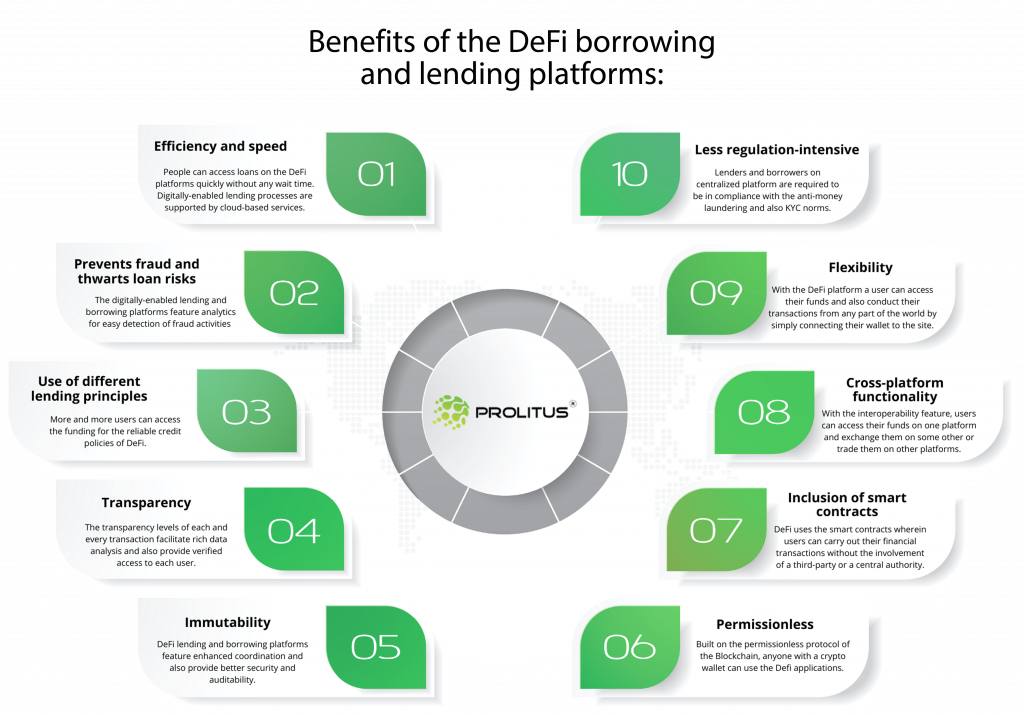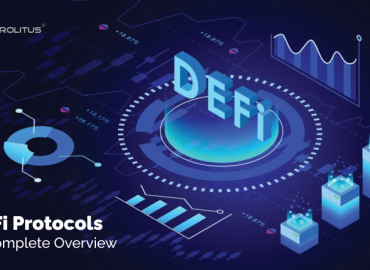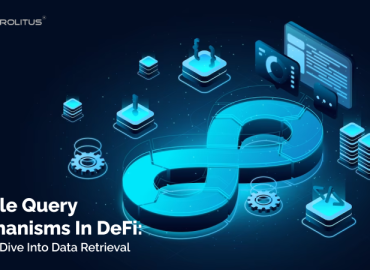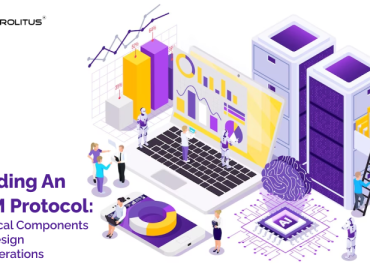One of the spaces in the financial tech domains that have been gaining traction and increased investor interest over 2021 and also as of March 2022 is the DeFi market. The projections state that the total value locked in the DeFi market was over USD 61 billion and much of the remarkable value has been contributed by the DeFi lending and borrowing platforms.
Business enterprises and start-ups across the world have started tapping into the lucrative opportunities thrown open by the expanding DeFi market by developing their own DeFi lending and borrowing software. Those who are at their nascent stage and also those who have already established their foothold in the market can expect to ride the next wave of growth of DeFi with the DeFi lending and borrowing platform. Here is a detailed blog piece highlighting the working model, features, benefits, and also challenges pertaining to this particular subject.
The popularity of DeFi powering Defi lending and borrowing platforms:
The accelerated adoption of blockchain technological solutions and their deployment for prominent industries such as supply chain, logistics, healthcare, and so on has yielded several advantages. Another major industry that has significantly benefited from the inclusion of blockchain solutions is the financial sector. There has been the inclusion of several blockchain-based fintech applications, including everything from digital payments to storage to crypto trading and so on, thus transforming the conventional norms. In fact, the introduction of DeFi has encouraged the entry of new participants, facilitating them with greater accessibility, reliability, transparency, and flexibility.
Given the innumerable advantages of decentralized finance, the defi developments are powering ahead, growing almost twenty folds in a year and almost every sector wants to realize its true potential. DeFi lending and borrowing platforms could forever transform the way people transact, store, receive, lend and even exchange currencies.
DeFi lending and borrowing platforms hold a lot of potentials. This blockchain solution for the financial sector provides many beneficial financial features that typically are lacking in centralized models. People with no access to banks or even financial institutions can take advantage of the DeFi and DeFi platforms.
Overview of DeFi P2P lending & borrowing platform development
In the traditional, centralized financial world, the lending and borrowing process involves the clients providing the required funds in exchange for a fixed interest rate. Users can earn money this way by lending their wealth. In this process, a centralized organization controls the process and also ensures that all the parties involved are in agreement with the terms and conditions and also follow them completely.
In the case of decentralized finance, users can lend their wealth to others without involving third parties or intermediaries. The smart contracts powering these DeFi platforms maintain that users conform to the rules and also agree with the terms of the loan. These contracts exist on the blockchain nodes and are executed under specific conditions.
The decentralized financing model facilitates different ways to lend and borrow for the users. Crypto asset holders with possession of several cryptocurrencies can trade or exchange these cryptos and also lend these digital assets to other parties at interest rates encoded in a smart contract.
Working model of a DeFi P2P lending & borrowing platform
In order to fully understand how decentralized finance lending and borrowing works we need to take a look at the working model of these innovative and valuable platforms.
The blockchain solution is integrated with the DeFi lending and borrowing platforms and powered by smart contracts. Hence, all the financial services will manage an unauthorized and encrypted process! These smart contracts-powered lending and borrowing platforms function without the interference of the third parties and are independent of intermediaries, thus offering freedom from any centralized control. With this useful platform, the lender and the borrower can conduct their lending and borrowing activities directly with no involvement of intermediaries. The peer-to-peer borrowing process empowers users to easily access financial support from the investors who provide money at an agreeable interest rate.
However, some experts advise against relating every blockchain-based financial app as a decentralized finance tool. It is important to understand the major set of differences between centralized finance and also the decentralized finance lending and borrowing platform.
Centralized finance is a blockchain-based application for financial functions such as lending and borrowing. In this financial model, the owner has complete authority over the security of assets as well as operations. In centralized finance platforms, KYC is mandatory for security reasons. Customers need to perform the compulsory KYC form fill-up in order to mitigate the risks.
As part of the decentralized financing platform that makes use of blockchain solutions for running its processes, the operations are conducted on a peer-to-peer basis. In decentralized financing platforms, users retain authority over their funds and store digital assets in the existing crypto wallets. The biggest feature of the Defi lending and borrowing platforms is the privacy and also the secrecy promised to the users. It does not require users to fill out the KYC forms and comply with the norms. The user privacy is respected while also facilitating those users to disperse their responsibilities with the help of smart contract integration.
Features of the DeFi lending process
DeFi lending process entails the following:
◆ Users access the platform to lend their digital assets and store their tokens in a secure location such as the “money market”.
◆ Deposits are organized by a smart contract where the terms for borrowing are also stipulated. The smart contracts are activated only when the user agrees to abide by the terms of the loan.
A number of reasons exist for which the DeFi lending and borrowing platforms use crypto assets in place of the fiat currencies. A lot of traders wish not to make their expenditures public on the platform, while many users may want to hold back their cryptos as the price fluctuates rapidly. Moreover, the token sales attract capital gain taxation, and investors would not want to bear the tax burden with the rebuying of these assets.
The Defi lending platform allows users to lend their digital assets and receive payment in terms of interest on the loan. Banks have been using this service for years, but now anyone can do it as well! A lender will be able to provide funds from which they’ll offer different rates depending upon how long one plans to keep the borrowed amount at any given time – all without having to take out another mortgage through traditional channels.
Users can store their funds into a pool and allocate them to borrowers with the use of smart contracts. Interest can be distributed to investors in a number of ways. Hence, it is worth spending some time researching and also identifying the interest type. It is the same with the borrowers and every pool type will have its own unique approach on how to borrow.
DeFi loans – different from traditional finance
In the conventional form of the fractional banking system, the lending and borrowing process takes place through banks and financial institutions. Under such systems, the customers deposit their excessive wealth in the banks, while those in need of more funds approach these banks and borrow them at an agreed-upon interest rate. In this process, the banks serve as a guarantor and also ensure that the money is returned within the stipulated time. In lieu of the funds, the borrower is required to pay an additional interest rate
Here, the bank acts as a guarantor and confirms the lender will receive their money within the specified term. The borrower will meanwhile return the required funds along with additional interest for borrowing this money. Even in the crypto world, people with excess cryptocurrencies can lend their assets to other users. But they do not require intermediaries. The transactions take place seamlessly without the involvement of a third-party.
In conventional forms of traditional financing such as taking out a bank loan requires the borrower to produce collateral. In case of non-payment of the loan amount, the bank or the lending financial institution holds the right to seize the collateral. It is the same with the decentralized system but the major differentiating factor is that there is no physical property required as collateral.
In order to secure a loan amount, the borrower requires putting up something more prized than the loan amount. They require smart contracts for depositing their digital assets or currencies of at least equivalent value to the loan amount. Crypto tokens can be used when borrowing cryptocurrencies.
For instance, a borrower requires depositing one price of the bitcoin if he borrows one bitcoin in DAI. However, The cost of collateral can reduce below the price you agreed to lend your funds, what do you do? There are two options available. The first option is simply not to repay any more than 150% worth. In fact, borrowers using the DeFo protocol – MakerDAO need to collateralize their loans at a minimum of 150% of the loan value. if someone borrows 100 DAI then they must return at least 75 extra DTAs (which works out as about 54 cents on each dollar). If this sounds like too much hassle for something so small, consider going with option Two instead – just sell some coins until their value reaches above stagnancy!
DeFi lending and borrowing platform development provide financial innovation
The launch of DeFi protocols has forever transformed the financial industry, changing the way users carry out their transactions. In fact DeFi is believed to be the primary driver of financial innovation and provides financial inclusion for the unbanked people with difficulty accessing bank loans.
Following are some of the major benefits of the DeFi borrowing and lending platforms:
Efficiency and speed
People can access loans on the DeFi platforms quickly without any wait time. There is quick provision of loans for borrowers and it is the limited waiting time that makes the DeFi lending platform a perfect choice for quick delivery of funds. Defi lending platforms provide fast processing speed. Digitally-enabled lending processes are supported by cloud-based services.
Prevents fraud and thwarts loan risks
The digitally-enabled lending and borrowing platforms feature analytics for easy detection of fraud activities and also have in place machine learning calculations for premium loan terms and calculation of risk factors. The advanced self-executing blockchain protocols accelerate the disbursal process of the loan. Once the loans are approved, lenders can send their offers via e-contracts.
Use of different lending principles
In the conventional systems, banking and other financial institutions follow a traditional approach of reviewing the scorecard and credit history. Detailed scrutiny of the credit scores often prevents quick access to loans for users with no established credit history. However, in case of DeFi – a fair, transparent approach is followed for credit policies. Hence more and more users can access the funding for the reliable credit policies of DeFi.

Less regulation-intensive
Lenders and borrowers on centralized platforms are required to be in compliance with the anti-money laundering and also KYC norms. There is mandatory KYC but decentralized platforms do not have compulsory regulatory KYC process but at the same time they ensure transparency and provide complete assurance to users of getting their funds back from the Defi platforms.
Flexibility
With the DeFi platform, a user can access their funds and also conduct their transactions from any part of the world by simply connecting their wallet to the site.
Cross-platform functionality
Another bigger feature of the DeFi platforms is the interoperable functionality which ensures that the Defi protocols and applications are well integrated and support one another. With the interoperability feature, users can access their funds on one platform and exchange them on some other or trade them on other platforms. It is with this cross-platform functionality that the DeFi drives the financial innovation thanks to the global interconnected network. Users can take advantage of the streamlined processes and also secure several user benefits.
Inclusion of smart contracts
In contrast to traditional finance, DeFi uses smart contracts wherein users can carry out their financial transactions without the involvement of a third party or a central authority. These self-executing blockchain-powered protocols do not require intermediaries.
Consistency in lending decisions
In DeFi lending and borrowing platforms, the rules around the credit policies ensure consistency with regard to the lending decisions. It altogether eliminates the need for disparities in assessment of the applicant attributes and organizing deals by underwriters.
Enhanced process and assured portfolio profits
The digital lending process in the DeFi platform makes use of analytics which can aid lenders and borrowers to make optimum gains. Lenders can track loan applications over a specified duration and also assign their resources to fit in as per the demands. With the use of analytics, they can improve performance and also increase the portfolio profitability with deeper insights into demographics, credit tiers and loan sources and so on. They could also assess how the credit policies affect the loan performance of the borrower.
Permissionless
Built on the permissionless protocol of the Blockchain, anyone with a crypto wallet can use the Defi applications from anywhere across the world and they do not require any minimum amount of funds either.
Transparency
Each and every transaction on the network is being broadcasted on the public blockchain and is also verified and validated by every user on the network. The transparency levels of each and every transaction facilitate rich data analysis and also provide verified access to each user.
Immutability
The decentralized framework of the self-executing blockchain-based protocols on which these DeFi platforms are developed ensures that the data remain immutable and cannot be altered or tampered with by anyone on the network. Hence the DeFi lending and borrowing platforms feature enhanced coordination and also provide better security and audibility.
Facilitates easy programmability
The self-executing blockchain-based Defi platforms of lending and borrowing feature programmability and can be easily automated. These digital lending and borrowing processes also come with the development of new digital assets and financial instruments.
Custody of assets in hands of participants
Participants of the DeFi market with the use of Web3 wallets such as the Metamask can be the safe custodian of their digital assets and also have complete authority over their data.
Popular Defi lending and borrowing platforms/ protocols
Maker – This exclusive Defi crypto lending platform lets the borrowers use only the DAI tokens, whose value is attached to US dollars. These stable coins can be generated as a debt against the collateral used by platform users for opening a vault, lock-in collateral like an ETH. Users can participate in the active earnings by paying the governance fees as interest rates for the network
Users can borrow DAI tokens up to more than 60 percent of the user’s collateral value and there is a penalty for users if the vault falls below the fixed rate. It might need liquidation to take the vault out of default and at a meager discount, the liquidated collateral can be sold in the open market.
The other token for Maker’s is MKR – the holders of which function as the last line of defense in case of any extraordinary event. MKR is minted when the collateral value begins falling and it is sold in an open market to raise more collateral by diluting these tokens.
Aave – This open-source and one of the highly in demand Defi lending protocols was developed in 2020, allowing lenders to store their cryptocurrencies in a pool and get an equivalent amount of tokens for their crypto assets. Users can earn interest on deposit and borrowing digital assets on this non-custodial liquidity protocol. This open-source liquidity DeFi protocol also adjusts interest rates algorithmically based on demand and supply. Users holding more tokens earn a better interest amount.
Compound – This protocol can help users discover a world of financial applications with its algorithmic and autonomous features. Users can store their cryptos and earn interest as well as borrow other digital assets against them. Capital storage and management on the platform are fully automated by use of smart contracts. Users could connect to this Defi lending protocol with the use of web 3.0 wallets such as Metamask and also earn good interest. This permissionless protocol allows anyone with a crypto wallet and an internet to interact freely. The governance token launched by this protocol is called “COMP”, facilitating voter rights to holders of digital tokens over things like the decision to include new assets, protocol upgrades and technical upgrades.
Essential features required for DeFi lending and borrowing platform development
With DeFi platforms emerging at the center of financial innovation and delivering valuable services to increase financial transparency and accessibility, several start-ups and new businesses are exploring this budding sector. A number of businesses are convinced of how the DeFi lending and borrowing platforms will transform the entire sector and they intend to leverage this with the development of a DeFi platform. However, the below stages need to be followed for a successful DeFi development platform:
Research and project specification
Businesses are required to form a proficient research team and understand the existing market landscape. This way they can also determine the requirements for the project. It will also help them to have an idea of the features that the platform will have and the audience they should target whereas also include the core functionalities of the platform.
Back-end development
In this stage of Defi lending and borrowing platform development, identify and clearly state the protocol that serves as the foundation for your platform. You can choose the blockchain network and also develop the site with rich, robust and secure features. Build the solutions based on the functionality you would want your Defi platform to possess.
Designing UI and UX
Focus on developing a DeFi lending and borrowing platform with a highly creative, user-friendly interface that is easy to navigate and explore. Complex features can reduce the accessibility of the DeFi platforms. Also, make sure that the DeFi platform features are sleek for users to keep coming back to it.
Testing
A quality analysis entailing bug testing is important to test that the development of the DeFi platform is in sync with the standards and requirements. It is also important to ensure that there are no security loopholes and flaws in the system during the trial and testing method. Having a dedicated QA team can help in assessing the product from the beginning till the end is necessary for rectifying and identifying any flaws, hiccups, and improving its overall performance.
Launch
Making your DeFi lending and borrowing development platform can turn out to be the next big thing. Ensure that you devise a smart marketing and advertising plan to make it a trending sensation that everyone would get attracted to for the decentralized features of the platform. Reach out to more and more users by designing the best marketing strategy for your DeFi platform and help them learn all the benefits that your developed platform has to offer.
Final thoughts
Undoubtedly, Defi lending and borrowing platforms hold a lot of promise to revolutionize the entire financial industry. With the introduction of this highly secure, transparent, immutable, and accessible decentralized finance, not just lending and borrowing but the whole range of financial services such as payments, investments, insurance, and trading are likely to undergo a big change. With the inclusion of intriguing blockchain technology, there are tremendous opportunities for developers to explore in the DeFi space.
Prolitus as a partner for DeFi lending and borrowing platform
Need an expert developer for your DeFi borrowing and lending platform? Prolitus holds that the future of finance is decentralized and we’re dedicated towards the mission of developing customized Defi solutions for the betterment of the financial industry. Our experts will help you ride this new wave with intriguing DeFi platform development services, so start today!





